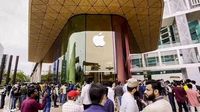Apple is once again poised to capture the world’s attention as it unveils its latest iPhone lineup on September 9, 2025, amid a swirling backdrop of international trade tensions, evolving technology, and fierce competition. The much-anticipated event, set at the company’s Cupertino, California headquarters and streamed globally, comes at a critical juncture for the tech giant—one defined as much by geopolitics and artificial intelligence as by the sleekness of its signature devices.
According to ABC and Business Wire, Apple’s annual product launch is always a spectacle, but this year’s unveiling carries an added layer of intrigue. The company’s marquee product faces potential price hikes thanks to the ongoing global trade war, which has seen President Donald Trump, now back in the White House, revive a campaign of tariffs aimed at pushing American companies to bring manufacturing home. The Trump administration, with U.S. Commerce Secretary Howard Lutnick at the forefront, has repeatedly insisted that iPhones be made in the United States rather than overseas. However, as Apple’s supply chain remains deeply rooted in China and India, analysts say the administration’s demand is unrealistic and could take years to implement—if it can be done at all. In fact, moving production stateside could double or even triple the iPhone’s average price, which currently hovers around $1,000.
Despite the pressure, Apple CEO Tim Cook has worked to shield the company from the brunt of these tariffs. Cook initially pledged a massive $500 billion investment in the U.S. over four years, then upped the ante to $600 billion last month, even gifting President Trump a statue with a 24-karat gold base as a diplomatic gesture. This deft maneuvering has helped Apple avoid some of the harshest tariffs, but imported iPhones are still slapped with a 25% duty. As a result, speculation is rife that Apple will announce its first across-the-board price increase in five years, with some models potentially jumping by $50 to $100 to protect profit margins. Since 2020, the company has charged $800 for its basic iPhone and $1,200 for its top-tier model.
Amid these uncertainties, Apple’s new iPhones—expected to be named the iPhone 17 series, following the tradition since 2007—are set to make their debut. Yet, the company has shown a willingness to break with convention: its latest iOS update will be called iOS 26, referencing the upcoming year, a move reminiscent of marketing strategies used by automakers. The new iPhones are still expected to roll off assembly lines in China and India, much to the chagrin of the Trump administration.
Market watchers are also zeroing in on what’s new inside the phones. According to Reuters and Mint, Apple is set to unveil four new models: iPhone 17, 17 Air, 17 Pro, and Pro Max. The most buzzed-about addition is the ultra-thin iPhone Air, which analysts say will be less than 5.5 mm thick, slotting between the standard iPhone 17 and the premium Pro models. This featherweight device is expected to go head-to-head with Samsung’s Galaxy S25 Edge and could be a stepping stone toward challenging Samsung’s folding phones, now in their seventh generation.
Viram Shah, Founder and CEO of Vested Finance, told Mint, “The company is expected to unveil four new iPhone 17 models (iPhone 17, 17 Air, 17 Pro, and Pro Max) with significant upgrades such as the new A19/A19 Pro chips, 120 Hz ProMotion displays across the lineup, improved cameras and performance, and a feather-thin Air model under 5.5 mm thick.” These upgrades, while substantial, are seen by some as incremental rather than revolutionary.
Indeed, expectations for a game-changing iPhone are muted this year. The iPhone 16, last year’s flagship, introduced a range of artificial intelligence features but fell short of delivering all the promised advancements—most notably, a smarter and more versatile Siri assistant. Those improvements have now been pushed to next year, leaving some analysts and consumers underwhelmed. “Apple is reaching a tipping point, and I expect 2026 and 2027 to be pivotal years,” said Forrester Research analyst Thomas Husson, as quoted by ABC.
Meanwhile, the competition isn’t standing still. Google recently unveiled its Pixel 10 smartphone, packed with advanced AI-powered tools that many Apple fans believe Siri should have offered years ago. This has intensified scrutiny on Apple’s delayed AI roadmap, with analysts predicting that the issue will dominate investor discussions in the months ahead.
Despite these challenges, Apple’s financial outlook is showing signs of resilience. On the morning of the big reveal, Apple shares dipped 0.6% to $236.22 on Nasdaq, but the company’s stock has rebounded 22% from its May lows, thanks in part to two major developments. First, President Trump stepped back from threatened tariffs on device imports, easing immediate fears of a trade war escalation. Second, a crucial court ruling in the Google antitrust case allowed Google to continue paying Apple $20 billion annually to keep its search engine as the default on iPhones—a lucrative arrangement that bolsters Apple’s bottom line.
Last quarter’s earnings report also brought some good news: iPhone sales grew 13% year-over-year, including modest gains in China after a period of market share losses. This uptick, coupled with Apple’s ability to sidestep the worst of the tariff threats, has buoyed investor sentiment. Still, as the global smartphone market matures and innovation cycles slow, Apple faces mounting questions about its ability to stay ahead of rivals in the age of artificial intelligence.
As the clock ticks down to the September 9 event—set to begin at 10:30 PM IST and streamed online—anticipation is running high. Will Apple’s latest devices dazzle consumers and investors alike, or will the combination of incremental updates, trade war pressures, and AI delays leave the tech titan playing catch-up? Only time will tell, but one thing’s certain: the stakes have rarely been higher for Apple as it seeks to maintain its place atop the world’s technology hierarchy.
For now, all eyes are on Cupertino, where Apple’s next move could shape not just its own future, but the direction of the global smartphone industry for years to come.






